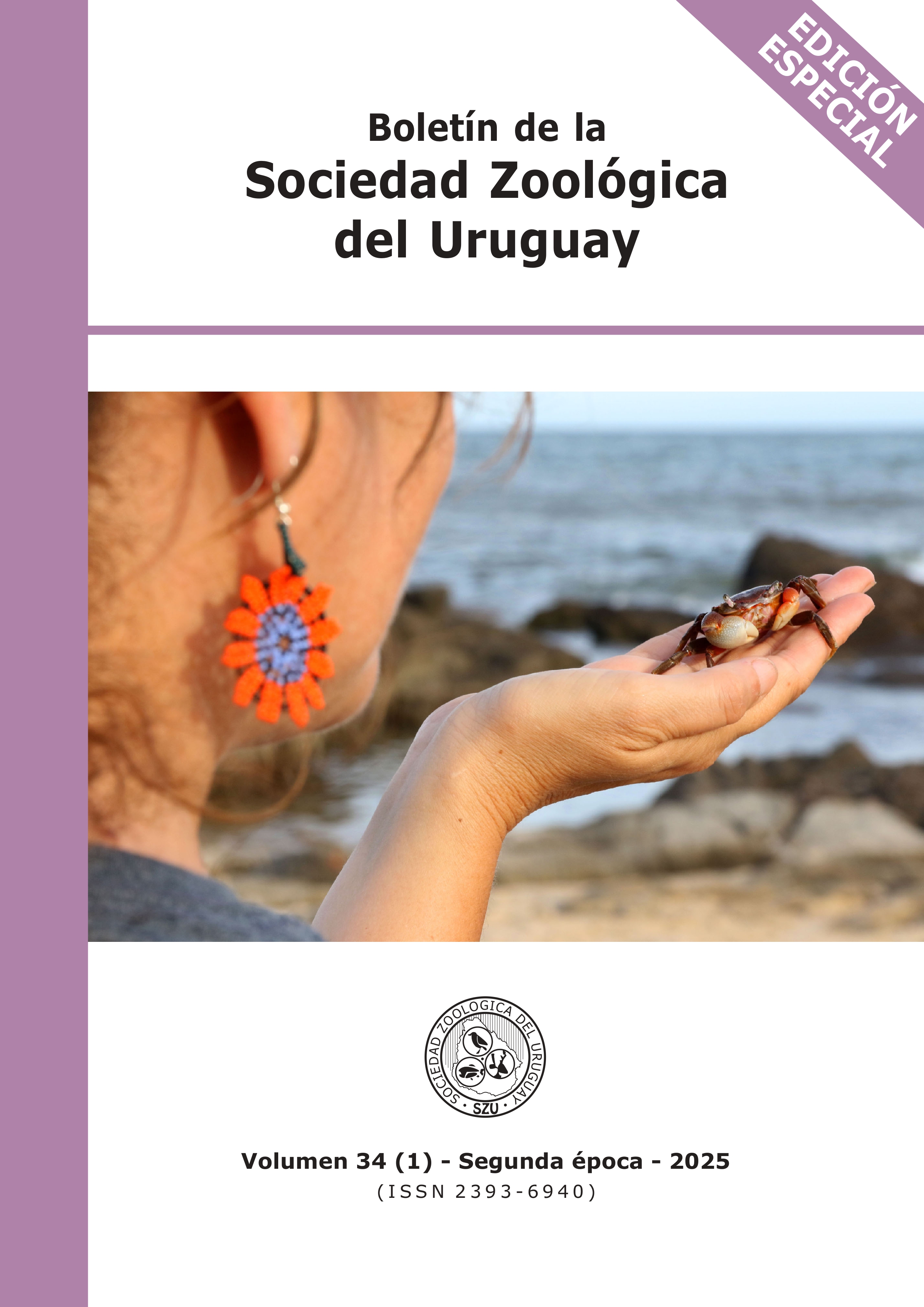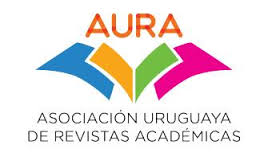CATÁLOGO ILUSTRADO DE NEMATODOS ESTUARINOS DE VIDA LIBRE DEL URUGUAY
DOI:
https://doi.org/10.26462/34.1.11Palabras clave:
Taxonomía, Nematodos, Lagunas y arroyos costeros, UruguayResumen
Los nematodos de vida libre son usualmente el componente dominante del bentos marino y estuarino, su diversidad y abundancia son clave para el funcionamiento de los ecosistemas acuáticos. La relevancia y la versatilidad del análisis de la comunidad de nematodos en el biomonitoreo del medio ambiente ya se ha demostrado en varias investigaciones oceánicas y costeras. Los estudios de nematodos han sido reemplazados frecuentemente por estudios ecológicos donde la identificación taxonómica se limita principalmente a nivel de género. Estos enfoques han permitido avanzar en la comprensión de muchos fenómenos de relevancia, los estudios taxonómicos clásicos y de distribución de especies siguen siendo cruciales, especialmente en ecosistemas estuarinos, prioritarios para la conservación de la biodiversidad, y que representan un recurso ecológico y económico clave. Este trabajo buscó contribuir al conocimiento taxonómico de las especies de nematodos de vida libre de hábitats estuarinos del Uruguay, constituyendo el primer registro de 22 especies. Debido al rol ecosistémico de los nematodos y a su desconocimiento en general es fundamental continuar aportando al conocimiento taxonómico del grupo en nuestro país.
Descargas
Citas
Armenteros, M., Pérez-García, J.A., Ruiz-Abierno, A., Díaz-Asencio, L., Helguera, Y., Vincx, M., & Decraemer, W. (2010), Effects of organic enrichment on nematode assemblages in a microcosm experiment. Marine Environmental Research, 70, 374-382.
Austen, M.C., & Somerfield, P.J. (1997). A community level sediment bioassay applied to an estuarine heavy metal gradient. Marine Environmental Research, 43, 315-328.
Baldrighi, E., Grall, J., Quillien, N., Carriço, R., Verdon, V., & Zeppilli, D. (2019). Meiofauna communities' response to an anthropogenic pressure: The case study of green macroalgal bloom on sandy beach in Brittany Estuarine. Coastal and Shelf Science, 227, 106326.
Barnes, N., Bamber, R.N., Moncrieff, C.B., Sheader, M., & Ferrero, T.J. (2008). Meiofauna in closed coastal saline lagoons in the United Kingdom: Structure and biodiversity of the nematode assemblage. Estuarine Coastal and Shelf Science, 79, 328-340.
Batallés, L.M. (1983). La comunidad de mejillón Mytilus edulis platensis (d´Orbigny, 1846) de Punta del Chileno (Maldonado Uruguay): distribución, composición y estructura de la población. Tesis de Licenciatura en Oceanografía Biológica, Facultad de Humanidades y Ciencias (Universidad de la República), Montevideo. 73 pp (Inédita).
Bouwman, L.A., Romeijn, K., & Admiraal, W. (1984). On the ecology of meiofauna in an organically polluted estuarine mudflat. Estuarine, Coastal and Shelf Science, 19, 633-653.
Chen, Z.X., Chen, S.Y., & Dickson, D.W. (2004). Nematology- Avances and Perspectives. Volume I: Nematode Morphology, Physiology and Ecology. CABI Publishing is a division of CAB International.
Conde, D., & Rodríguez-Gallego, L. (2002). Problemática ambiental y gestión de las lagunas costeras atlánticas de Uruguay. Perfil Ambiental 2002. Domínguez A & Prieto R (Eds.). NORDAN, Montevideo. 149-166 pp.
Danovaro, R. (2000). Benthic microbial loop and meiofaunal response to oil-induced disturbance in coastal sediments: a review. International Journal of Environment and Pollution, 13, 380-391.
Eyualem-Abebe, E., Andrássy, I., & Traunspurger, W. (eds). (2006). Freshwater Nematodes: Ecology and Taxonomy. CABI Publishing, Oxfordshire, 253 pp.
Furstenberg, J. P., & Vincx, M.M. (1989). Two oncholaimid species from a South African estuary (Nematoda, Oncholaimidae). Hydrobiologia, 184, 43-50.
García, R., & Johnstone, R.W. (2006). Effects of Lyngbya majuscula (Cyanophycea) blooms on sediment nutrients and meiofaunal assemblages in seagrass beds in Moreton Bay, Australia. Marine and Freshwater Research, 57, 155-165.
Gheskiere, T., Hoste, E., Vanaverbeke, J., Vincx, M., & Degraer, S. (2004). Horizontal zonation pattern sandfeeding structure of marine nematode assemblages on a macrotidal, ultra-dissipative Sandy beach (DePanne, Belgium). Journal of Sea Research, 52, 211-226.
Gheskiere, T., Vinck, M., Weslawski, J.M., Scapini, F., & Degraer, S. (2005a). Meiofauna as descriptor of tourism-induced changes at sandy beaches. Marine Environmental Research, 60, 245-264.
Gheskiere, T., Vinck, M., Urban-Malinga, B., Rossano, C., Scapini, F., & Degraer, S. (2005b). Nematodes from wave-dominated sandy beaches: diversity, zonation patterns and testing of the isocommunities concept. Estuarine, Costal and Shelf Science, 62, 365-375.
Giere, O. (1993). Meiobenthology: The Microscopic Fauna in Aquatic Sediment. Springer, Berlin,
pp.
Giere, O. (2009). Meiobenthology: The Microscopic Motile Fauna of Aquatic Sediments, second ed.
Springer-Verlag, Berlin.
Giménez, J.L., Dimitriadis, C., Carranza, A., Borthagaray, A.I., & Rodríguez, M. (2006). Unravelling the complex structure of a benthic community: A multiscale-multianalytical approach to an estuarine sandflat. Estuarine, Coastal and Shelf Science, 68, 462-472.
Gyedu-Ababio, T.K., Furstenberg, J.P., Baird, D., & Vanreusel, A, (1999). Nematodes as indicators of pollution: a case study from the Swartkops River estuary, South Africa. Hydrobiologia, 397, 155-169.
Hendelberg, M., & Jensen, P. (1993). Vertical Distribution of the nematode fauna in a coastal sediment influenced by seasonal hypoxia in the bottom water. Ophelia, 37, 83-94.
Higgins, R.P., & Thiel, H. (Eds.). (1988). Introduction to the Study of meiofauna. Washington, DC, Smithsonian Institution press, 488p.
Holovachov, O., Zullini, A., Loof, P.A.A., & Bongers, T. (2002). Morphology and systematics of the genus Anonchus Cobb, 1913 (Nematoda: Leptolaimina) and reappraisal of the family Aphanolaimidae Chitwood, 1936. Nematology, 4, 725-757.
Hong, J.H., Semprucci, F., Jeong, R., Kim, K., Lee, S., Jeon, D., … Le, W. (2020). Meiobenthic nematodes in the assessment of the relative impact of human activities on coastal marine ecosystem. Environmental Monitoring Assessment, 192, 81 https://doi.org/10.1007/s10661-019-8055-2.
Howard, M., & Platt, F.L.S. (1985). The free-living marine nematode genus Sabatieria (Nematoda: Comesomatidae). Taxonomic revision and pictorial keys. Zoological Journal of the Linnean Society, 83, 27-78.
Hua, E., Mu, F., & Zhang, Z. (2016). Nematode community structure and diversity pattern in sandy beaches of Qingdao, China. Journal of Ocean University of China, 15, 33-40.
Ingole, B.S., Goltekar, R., Gonsalves, S., & Ansari, Z.A. (2005). Recovery of deep-sea meiofauna after artificial disturbance in the Central Indian Basin. Marine Georesources and Geotechnology, 23, 253-266.
Kandratavicius, N., Giménez, L., Pastor de Ward, C., Venturini, N., & Muniz, P. (2024). Linking Biodiversity and Functional Patterns of Estuarine Free-Living Nematodes with Sedimentary Organic Matter Lability in an Atlantic Coastal Lagoon (Uruguay, South America) Diversity, 16(11), 688; https://doi.org/10.3390/d16110688.
Kandratavicius, N., Muniz, P., Venturini, N., & Giménez, L. (2015). Meiobenthic communities in permanently open estuaries and open/closed coastal lagoons of Uruguay (Atlantic coast of South America). Estuarine Coastal and Shelf Science, 163, 44−53.
Kandratavicius, N., Pastor de Ward, C., Venturini, N., Giménez, L., Rodriguez, M., & Muniz, P. (2018). Response of estuarine free-living nematode assemblages to organic enrichment: an experimental approach. Marine Ecology Progress Series, 602, 117-133.
Kapusta, S.C., Wurdig, N.L., Bemvenuti, C.E., & Pinto, T.C. (2006). Acta Limnologica Brasiliensia, 18, 133-144.
Lambshead, P.J.D. (1986). Sub-catastrophic sewage and industrial waste contamination as revealed by marine nematode faunal analysis. Marine Ecology Progress Series, 29, 247- 260.
Lambshead, P.J.D., Brown, C.J., Ferrero, T.J., Mitchell, N.J., Smith, C.R., Hawkins, L.E., & Tietjen, J. (2002). Latitudinal diversity patterns of deepsea marine nematodes and organic fluxes a test from the central equatorial Pacific. Marine Ecology Progress Series, 236, 129-135.
Lambshead, P.J.D., Tietjen, J., Moncrieff, C.B., & Ferrero, T. (2001). North Atlantic latitudinal diversity patterns in deep-sea marine nematode data: a reply to Rex et al. Marine Ecology Progress Series, 210, 299-301.
Lampadariou, N., Karakassis, I., & Pearson, T.H. (2005). Cost/benefit analysis of a benthic monitoring programme of organic benthic enrichment using different sampling and analysis methods. Marine Pollution Bulletin, 50, 1606-1618.
Leduc. D., & Wharton, D.A. (2010). New free-living marine nematode species (Nematoda: Desmodoridae) from the coast of New Zealand. Zootaxa, 2611, 45-57.
Lorenzen, S., Prein, M., & Valentin, C. (1987). Mass aggregation of the free-living marine nematode Pontonema vulgare (Oncholaimidae) in organically polluted fjords. Marine Ecology Progress Series, 37, 27-34.
Maytía, S., & Scarabino, V. (1979). Las comunidades del litoral rocoso del Uruguay: zonación, distribución local y consideraciones biogeográficas. Pp 149-160 En Memorias del Seminario sobre Ecología Bentónicas y Sedimentación de la Plataforma Continental del Atlántico Sur (Montevideo, 9-12 de mayo de
. UNESCO, ORCYT.
Montagna, P.A., & Harper, D.E. (1996). Benthic infaunal long-term response to offshore production platforms in the Gulf of Mexico. Canadian Journal of Fisheries and Aquatics Sciences, 53, 2567-2588.
Moreno, M., Semprucci, F., Vezzulli, L., Balsamo, M., Fabiano, M., & Albertelli. G. (2011). The use of nematodes in assessing ecological quality status in the Mediterranean coastal ecosystems. Ecological Indicators, 11, 328-336.
Neira, C., Sellanes, J., Soto, A., Gutiérrez, D., & Gallardo, V.A. (2001). Meiofauna and sedimentary organic matter off central Chile: response to changes caused by the 1997-98 El Niño. Oceanologica Acta, 24, 313-328.
Obenat, S., Ferrero, L., & Spivak, E. (2001). Macrofauna associated with Phyllochaetopterus socialis aggregations in the southwestern Atlantic. Vie et Milieu, 51(3), 131-139.
Pastor de Ward, C.T., Lo Russo, V., & Varisco, M. (2018). Free-living marine nematode communities in San Jorge Gulf, Argentina. Oceanography, 31, 113-121, https://doi.org/10.5670/ oceanog.2018.415.
Perez-Garcia, J.A., Armenteros, M., Diaz-Asencio, L., Diaz-Asencio, M., Ruiz-Abierno, A., Fernadez- Garces, R., Bolaños-Alvarez, Y., & Alonso-Hernandez, C. (2009). Spatial distribution of nematode assemblages in Cienfuegos Bay (Caribbean Sea), and their relationship with sedimentary environment. Meiofauna Marina, 17, 71-81.
Platt, H.M., & Warwick, R.M. (1980). The significance of free-living nematodes to the littoral ecosystem. 729-759pp. En The Shore Enviroment Vol 2. Ecosystems. Price JH, Irvine DEG & Farnham WF (Eds.). Academic Press, New York.
Platt, H.M., & Warwick, R.M. (1983). Free living marine nematodes. Parte I British Enoplids. Published for The Linnean Society of London & The Estuarine & Brackish-Water Sciences Association. Cambridge University Press.
Platt, H.M., & Warwick, R.M. (1988). Free living marine nematodes. Parte II British Chromadorids. Synopses of the British Fauna (New Series) edited by Kermack DM & Barnes RSK. Published for The Linnean Society of London & The Estuarine & Brackish-Water Sciences Association.
Riestra, G., Giménez, J.L., & Scarabino, V. (1992). Análisis de la comunidad macrobentónica infralitoral de fondo rocoso en Isla Gorriti e Isla de Lobos (Maldonado, Uruguay). Frente Marítimo 11, 123-127.
Scarabino, F. (2006). Faunística y taxonomía de invertebrados bentónicos marinos y estuarinos de la costa uruguaya En Menafra R, Rodríguez-Gallego L, Scarabino F & D Conde (eds) (2006) Bases para la conservación y el manejo de la costa uruguaya. VIDA SILVESTRE URUGUAY, Montevideo. i-xiv+668pp.
Schratzberger, M., & Ingels, J. (2018). Meiofauna matters: The roles of meiofauna in benthic ecosystems. Journal of Experimental Marine Biology and Ecology, 502, 12-25.
Schratzberger, M., Warr, K., & Rogers, S.I. (2006). Patterns of nematode populations in the southwestern North Sea and their link to other components of the benthic fauna. Journal of Sea Research, 55, 113- 127.
Shimada, D.,Takeda, N., Tsune, A., & Murakami, C. (2020). Three new species of free-living marine nematodes (Nematoda: Enoplida) from the Clarion-Clipperton Fracture Zone (CCFZ), North Pacific. Zootaxa, 4859, 507-526.
Soetaert, K., Muthumbi, A., & Heip, C. (2002). Size and shape of ocean margin nematodes: morphological diversity and depth-related patterns. Marine Ecology Progress Series, 242, 179-193.
Tchesunov, A.V. (2000). Descriptions of Pseudosteineria horrida (Steiner, 1916) and P. ventropapillata sp nov from the white sea with a review of the genus Wieser, 1956 (NEMATODA: MONHYSTERIDA: XYALIDAE). Annales zoologici (Warszawa), 50, 281-287.
Tchesunov, A.V., & Thanh, N.V. (2010). A description of Anoplostoma nahatrangensis sp.n. from mangrove habitats of Nha Trang, Central Vietnam, with a review of genus Anoplostoma Bütscheli, 1874 (Nematoda: Enoplida). Invertebrate Zoology, 7, 93-105.
Tietjen, J.H., & Lee, J.J. (1984). The use of free-living nematodes as a bioassay for estuarine sediments. Marine environmental research, 11, 233-251.
Traunspurger, W. (2009). Nematoda. En Likens GE (Ed.) Encyclopaedia of Inland Waters. Oxford Elsevier, 2, 372-383.
Venekey, V. (2007). Actualização do conhecimento taxonomico dos Nematoda brasilera e sua ecología na praia de Tamandare PE (Brasil). Recife, Brasil. 144pp.
Venekey, V., Fonseca-Genevois, V.G., & Santos, P. (2010), Biodiversity of free-living marine nematodes on the coast of Brazil: a review. Zootaxa, 2568, 39-66.
Venturini, N., Muniz, P., & Rodríguez, M. (2004). Macrobenthic subtidal communities in relation to sediment pollution: the phylum-level metaanalysis approach in a south-eastern costal region of South America. Marine Biology, 144, 119-126.
Vieira, D.C., & Fonseca, G. (2013). The Importance of Vertical and Horizontal Dimensions of the Sediment Matrix in Structuring Nematodes Across Spatial Scales. PLoSONE. doi:10.1371/journal.pone.0077704.
Villares, M.G., Lo Russo, V., & Pastor de Ward, C.T. (2015). A new species of Pontonema (Oncholaimidae, Nematoda) and a redescription of Pontonema incisum Wieser, 1953 from Santa Cruz and Chubut Provinces, Argentina. Zootaxa, 4058; 3; 12-2015, 417-428.
Warwick, R.M., Platt, H.M., & Somerfield, P.J. (1998). Free living marine nematodes. Parte III British Monhysterids. Published for The Linnean Society of London & The Estuarine & Brackish-Water Sciences Association. Field Studies Council Shrewsbury.
Wieser, W. (1954). Free living marine nematodes. Parte II Chromadoroidea. Reports of The Lund University Chile Expedition, 1948-1949.
Yodnarasri, S., Montani, S., Tada, K., Shibanuma, S., & Yamada, T. (2008). Is there any seasonal variation in marine nematodes within the sediments of the intertidal zone? Marine Pollution Bulletin, 57, 149-154.
Zeppilli, D., Sarrazin, J., Leduc, D., Arbizu, P.M., Fontaneto, D., Fontanier, C., Gooday, A.J., … Fernandes, D. (2015). Is the meiofauna a good indicator for climate change and anthropogenic impacts? Marine Biodiversity, 45, 505-535.











